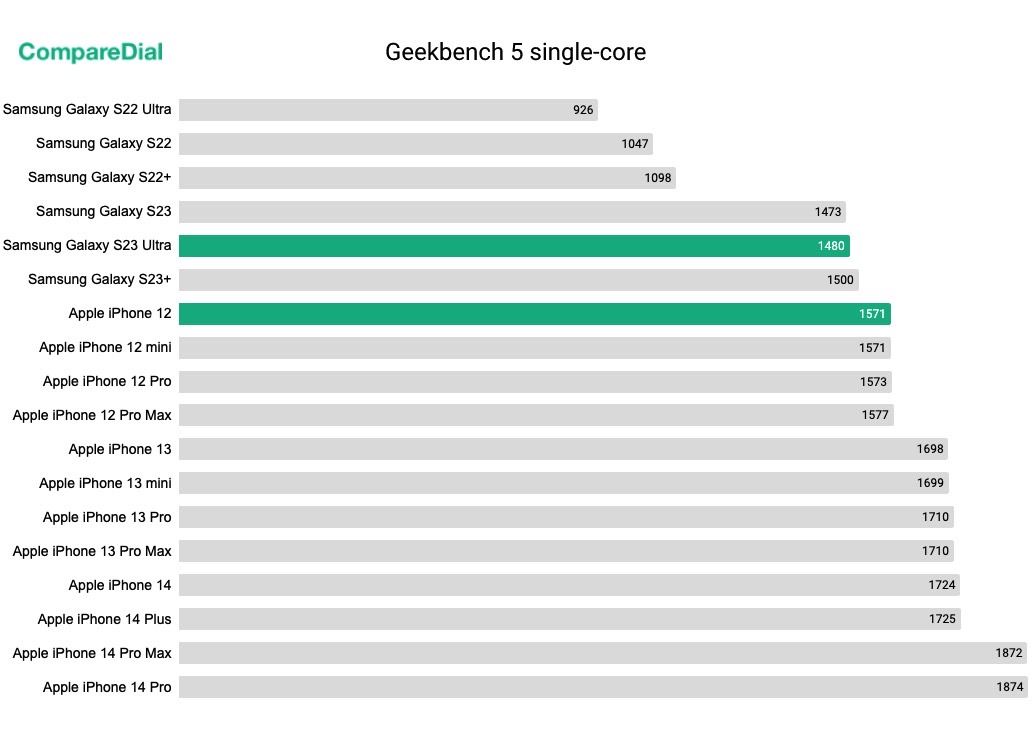The iPhone 14 and 14 Plus are hardly selling as well as expected, as buyers overwhelmingly favor the iPhone 14 Pro and 14 Pro Max. That’s partly Apple’s own doing, as its marketing failed to make the non-Pro models more compelling. The phones look like the iPhone 13 handsets, and they rock the same chip generation. That’s what most people would say.
The actual truth is that the iPhone 14 and 14 Plus are the direct descendants of the iPhone 13 Pro and 13 Pro Max. They’re not the successors of the non-Pro iPhone 13 models. As I explained before, the iPhone 14 and 14 Plus are formidable phones that deliver flagship performance, even with last year’s chips.
Apple’s latest disclosures about the iPhone 14 design explain why that non-Pro iPhone 14’s performance might be even better than the iPhone 13 Pros.
As the recent set of Galaxy S23 Ultra benchmarks has shown, the A15 Bionic that powers the iPhone 13 and non-Pro iPhone 14 models is the best alternative to the A16 Bionic inside the iPhone 14 Pro models.
Apple didn’t just use the base A15 Bionic chip inside the base iPhone 13 models. Instead, it went for the System-on-Chip (SoC) variant that features an extra GPU core and 6GB of RAM instead of 4GB. That’s a solid upgrade for the iPhone 14 and 14 Plus. It essentially gives you the ability to purchase an iPhone 13 Pro or 13 Pro Max for a much lower price.
What you lose from the Pro experience is the 120Hz display, the stainless steel frame, and the telephoto lens on the back. But the iPhone 14 and 14 Plus do feature the performance you need to keep using the phones for several years. Despite the notch design and the “old” A15 Bionic chip.
Somehow, that message got lost in translation when Apple unveiled the iPhone 14 series. Or maybe Apple just wanted more people to pay more money for the more expensive iPhone 14 Pro and 14 Pro Max than properly market the iPhone 14 and 14 Plus.

But Apple won’t stop making cheaper models. And the iPhone 15 series will feature direct successors to the iPhone 14 and 14 Plus that will probably rock iPhone 14 Pro and 14 Pro Max hardware.
Meanwhile, Apple did reveal exciting details about how the iPhone 14’s internal designs differ from its predecessors. Apple made various changes to improve repairability and reduce the costs of repairs. We’ve already covered the main iPhone 14 design points from The Sydney Morning Herald’s interview with Apple’s senior director of iPhone design, Richard Dinh.
There’s one change inside the phone that also helps improve cooling the handset:
For the iPhone 14, the design changed drastically to include a central aluminum structure that acts as a backbone. Now the phone can be opened by removing the display or the back glass.
This central structural plane helps to dissipate more heat across the entire surface more consistently,’ Dinh said.
In turn, this helped Apple remove a copper alloy cooling piece from the handset and connecting components. This allowed Apple to shed 40 grams of components if you compare the iPhone 13 Pro Max and iPhone 14 Plus.
The cooling detail is very interesting here. All smartphone chips will throttle performance once they heat up, and the iPhone will do it. And nobody wants their smartphone to overheat and the battery life to take a hit during peak performance. Therefore, the better the cooling of a phone, the higher the peak capabilities.
The point here is that the non-Pro iPhone 14 models should offer better peak performance than the iPhone 13 Pros they replace. Even if it’s marginal, it’s still an improvement. And a detail that might count if you need a more affordable iPhone to last you several years.
It so happens that a recent set of benchmarks comparing the Galaxy S23 phones to all iPhones Apple launched since 2020 proves that detail (check out the image above). The iPhone 14 and 14 Plus are marginally faster than the iPhone 13 Pro variants.








